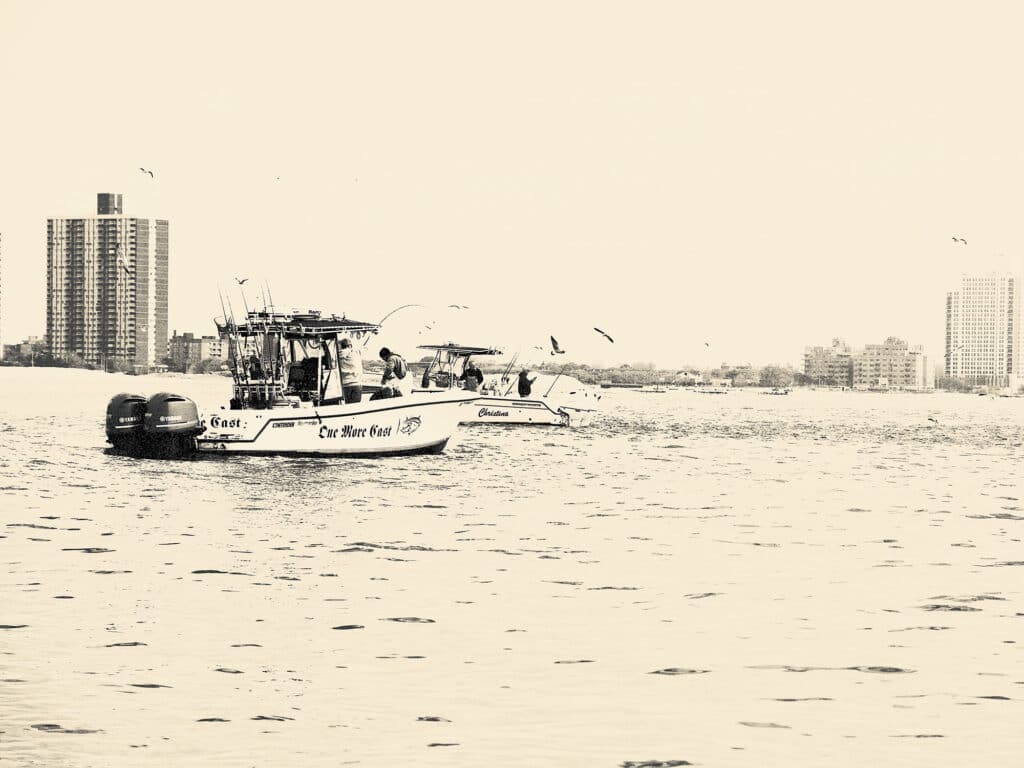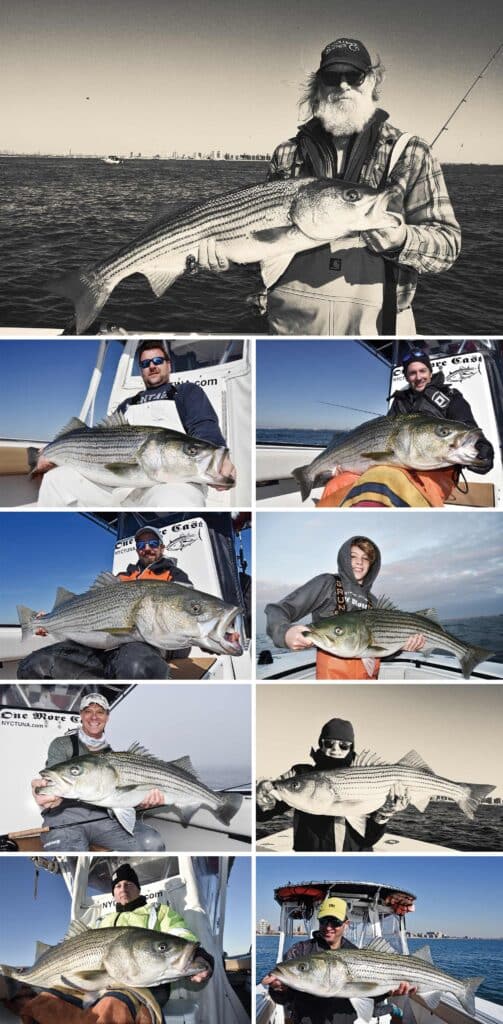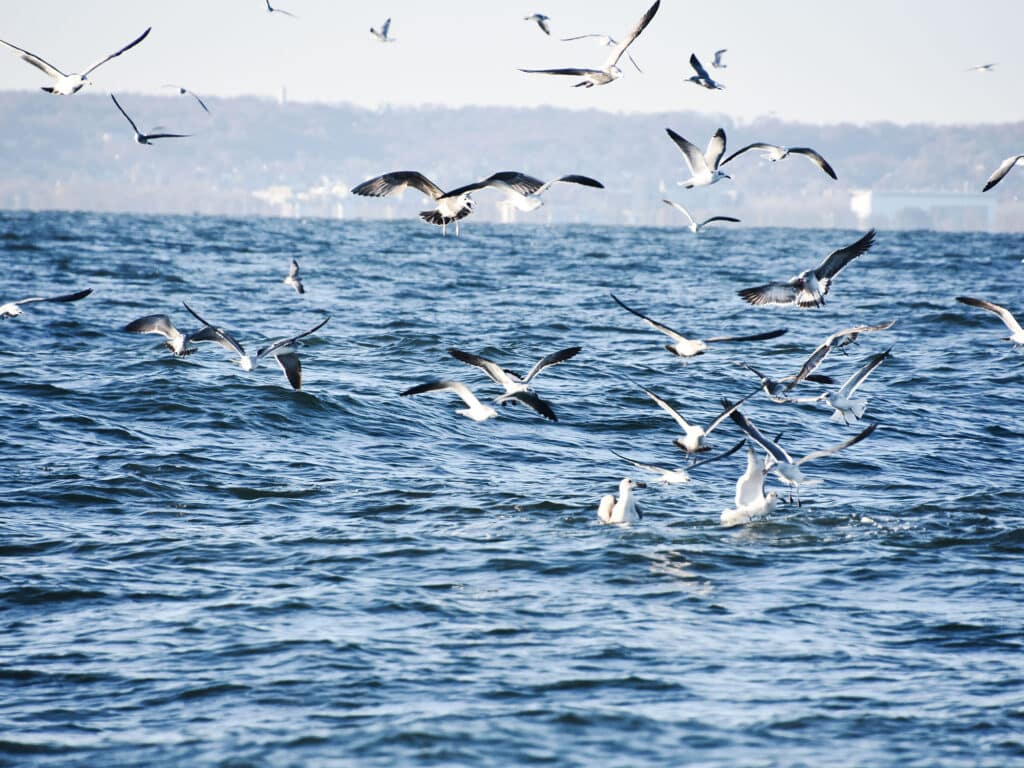
We were fishing big gear for bluefin tuna—which had shown up relatively close to shore—when one of the rods goes off. A few short, uneventful moments later, and I’m freaking out because we’re looking at the largest striper I’ve ever seen. After a quick measurement and photo, we sent her on her way. A whopping 55-inch fork length, and this thing was fat! Well over the 60-pound mark.
That was just the beginning. For weeks, from right up on the beach to a few miles out, the largest concentration of 30-plus-pound bass I’ve ever witnessed were crushing plugs along the edges of massive bunker schools. I mean, seriously. We saw more 50-pound-class fish in the space of a few weeks than I’ve seen in the two decades I’ve been running striped bass charters.
By November, as peanut bunker left the estuaries, we became flooded with fish in the 26- to 35-inch range. Raging blitzes became a daily occurrence.
This was not just happening in my neck of the woods (Western Long Island). It was happening from Montauk to Cape May. Yeah man, October and November were simply the best two months of striped bass fishing that just about all of us had ever seen in decades.
As I write this in December, it’s still schoolie city out there. Acres of stripers in the 20- to 30-inch range continue to blast peanut bunker schools. It won’t last much longer, but it’s shown no sign of slowing down.
After nearly a decade of declining striped bass availability along the coast, this fall is reminiscent of the glory days. But has there been a definitive increase in striped bass abundance? Is this going to be the new normal? I think it’s too early to make that assumption.

Indeed, while the New York-New Jersey area seems to be the epicenter of a “perceived superabundance,” I should acknowledge a perceived lack of fish in the Chesapeake. But it’s clear at this point that striped bass numbers and availability were up (in most cases way up), at least from Maine to Delaware this year. And let’s be clear about something else: Yeah, fall was off the hook, but the spring here was pretty darn good too. And the summer months in Montauk, Rhode Island, the Cape, even all the way up to Maine? Well, most guys will tell ya they’ve been seeing more fish.
These numbers don’t appear to be a one-year thing. This year was insanely good, but we’ve seen a steady increase over the past few seasons too, particularly in larger, more fecund females. This isn’t anecdotal. According to the latest stock-assessment update, striped bass numbers are indeed increasing.
But Why?
While there’s probably no single answer here, there certainly does seem to be a direct correlation to management actions.
In 2019, after more than a decade of declining numbers, the agency that manages striped bass acknowledged that overfishing had been occurring for quite some time. The stock had become overfished. Instead of “constraining fishing mortality” by raising the size limit, it chose to implement a slot limit. The lower size would stay the same, but you couldn’t keep fish 35 inches or longer.
A lot of people at the time didn’t like this move, for a lot of reasons, myself included. But it does seem like it’s working. And working well, particularly in regard to the availability of larger fish.
I mean, really, why else would we be seeing and have access to all these trophy fish in the last few years? While it seems like an explanation that’s just way too simple—and yes, maybe premature—it’s not unreasonable to contend that these big fish are available to us in increasing numbers because they aren’t ending up in someone’s cooler. If you don’t kill big fish, they are still in the water for folks to catch, right? A lot of the larger fish we have been catching have clear signs of being caught before (scarring on and around the jaw).
But the slot has only been in place for three seasons. Those big fish, particularly the 50s, had to survive for many years without its benefit. The question is, where were those fish before? Were they around and just under a lot more pressure, so we just weren’t seeing them in great numbers? And how do we explain the extraordinary numbers of slot-size fish showing up?
Read Next: 10 Record-Setting Striped Bass Catches

There are likely a few things in play here, and thus a few assumptions we can make. Without getting too techie, though, the fish that are falling into the slot size right now are likely one of the strong Chesapeake Bay year classes (2011 and 2015) recruiting into the fishery. And those 30s to 50s? Likely other good year classes—2001 and 2003.
But really, the slot limit’s general effect seems to be that it has worked to reduce fishing mortality overall. It sure does seem like we’re killing fewer fish. According to the stock-assessment update, fishing mortality is down quite a bit from where it was before the slot limit was put into effect. And the stock-assessment update was clear in its assumption that we’re no longer overfishing. This has been clear on the water. It’s just harder to catch a slot fish than it is to simply catch a fish over 28 inches, particularly with all those larger fish around.
The logic makes sense. But I’ve been around long enough to know that things can and do change rapidly, sometimes drastically and inexplicably, in the space of a few years.
And just to throw some more cold water on things, we’ve got to be aware of recruitment problems in the Chesapeake Bay (by far the largest producer of the fish that join the coastal stock). Their juvenile abundance surveys have shown a definitive decline in productivity. While we may be seeing a good number of fish from a few good year classes produced long ago, there doesn’t appear to be much behind them. Although, there’s some evidence indicating the Hudson and Delaware estuaries might be picking up the slack.
Managers played the slots, and while maybe it’s still to early to tell, given this year’s fall run, maybe they hit the jackpot?
That would be a good thing—if the bet holds out.









